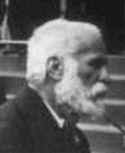| GAUDÍ - The Man | Biographic Synthesis Extended Biography Chronology Influences Gaudí's Political and Patriotic Sentiment Gaudí's Friends Gaudí's Collaborators |
| The Work | Architectonic Work Characteristic Styles Technical Aspects Decorative Aspects - Ceramics | Furniture | Iron and Other Metals | Stained Glasses |
| Sources and Other Information | Links & Bibliography |
Gaudí’s Political and Patriotic Sentiment
Gaudí was a fervent Catalan patriot throughout his life. This is evidenced not only by the extensive anecdotes reflecting such a political position and by the many protestations of his well-known and energetic defenses of Catalan language and traditions, but also by the abundant presence of Catalan national symbols found in all his works. The four bars and the cross of St. George are present in different forms in the decoration of his buildings. Especially during his youth, Gaudí was extraordinarily interested in knowing everything about his country. To that end, the joined the Associació Catalanista d’Excursions Científiques (Catalanist Association for Scientific Excursions), where he worked alongside a group of passionate patriots in defense of the art, landscape, culture, and language of Catalunya.
Although a dedicated Catalan patriot, in social terms Gaudí was rather conservative, despite Ruskin’s influence. It has been said that he was a staunch enemy of industrialization, but we cannot be certain, since the political environment in which he lived as a young man in an industrial city like Reus (then the second city of Catalunya) with a significant working class population tended toward the revolutionary, as manifested by the many demonstrations, rallies, secret meetings, coups, and rebellions celebrated during Gaudí’s youth. The revolution of September 1868 left a particularly significant impression on the 14 year-old Gaudí.
From the Catalan nationalist point of view, this was also a time of great effervesence. The Renaixena began a rapid and active expansion in 1860. The Jocs Florals (literary competitions) were reinstated and in 1865 honored Father Jacint Verdaguer. Architecture, literature, theatre, sculpture, and music were seized by a new energy that extended not only throughout Catalunya proper, but also to Valencia, Mallorca, and Catalunya Nord/Rousillon, all of which renewed their literary use of the language. This impulse extended also to our sister culture in l’Occitane, where, spurred on by Frédéric Mistral, it once again took flight.
Despite his Catalanist convictions, Gaudí never actively participated in politics, unlike his colleagues Lluís Domènech i Montaner and Josep Puig i Cadafalch.
His view of politics was essentially an upright and Catalanist one: “One cannot kill a people. Voices can be drowned out, outlets can be closed, but then the pressure builds, and the danger of explosion grows. And if too many outlets are closed, explosion is inevitable.”
Gaudí’s Catalanism manifested itself from the project design of his buildings to their ornamental details, all of which have a clear aesthetic sense of belonging to one territory: Catalunya. This characteristic is inseparable from the architect’s ideology and attitude toward the nationalist project, evidence by many, many words and deeds. For instance, when philosopher Miguel de Unamuno visited the Sagrada Família site, poet Joan Maragall had to translate Gaudí’s Catalan tour into Spanish. Episodes of this sort happened throughout Gaudí’s life.
During the Jocs Florals celebration in 1920 (which ended in a small revolt), Gaudí received cudgel blows from the police; luckily some bystanders helped him out of the altercation, because while he was being hit, the architect called his oppressors “miserable.”
On September 11, 1924, when General Primo de Rivera’s dictatorship was in full swing and Gaudí was 72 years old, he was detained on the way to the church of Sant Just to attend a mass in memory of patriots fallen during the defeat of 1714. The Guardia Civil had barricaded the entrance to the church, and Gaudí protested. The architect was not in the least intimidated by authority and naturally engaged them in Catalan, refusing to do so in any other language. Therefore he was detained and sentenced to pay a fine of fifty pesetas.
Gaudí’s own words about the repression of the Catalan nation and its people—spoken in 1924 right after being released from detention for speaking in Catalan—make clear his concern and his firm position: “When I look back on what has happened, I am worried that we are going down a dead-end path, and at the end we will have to make a radical turn.” Even now, 85 years later, the Catalan nation still has to continue its fight in seach of national recognition and in defense of its language.
Some authors, particularly J.M. Carandell, attribute Gaudí’s sympathies to Masonry, finding in his work a certain abundance of symbology, but beyond that we have no irrefutable sources on this theme, which would in any even contrast sharply with his known religious, Catholic beliefs.

